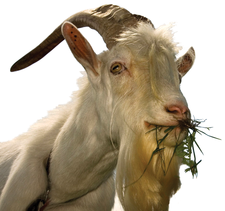Car NOT Goat
Programming Snapshot – Neural Networks

© Lead Image © Frantisek Hojdysz, 123RF.com
The well-known Monty Hall game show problem can be a rewarding maiden voyage for prospective statisticians. But is it possible to teach a neural network to choose between goats and cars with a few practice sessions?
Here's the problem: In a game show, a candidate has to choose from three closed doors; waiting behind these doors is a car, which is the main prize, a goat, and yet another goat (Figure 1). The candidate first picks a door, and then the presenter opens another, behind which there is a bleating goat. How is the candidate most likely to win the grand prize: Sticking with their choice or switching to the remaining closed door?
As has been shown [1] [2], the candidate is better off switching, because then they double their chances of winning. But how does a neural network learn the optimal game strategy while being rewarded for wins and punished for losses?
[...]
Buy this article as PDF
(incl. VAT)
Buy Linux Magazine
Subscribe to our Linux Newsletters
Find Linux and Open Source Jobs
Subscribe to our ADMIN Newsletters
Support Our Work
Linux Magazine content is made possible with support from readers like you. Please consider contributing when you’ve found an article to be beneficial.

News
-
Parrot OS Switches to KDE Plasma Desktop
Yet another distro is making the move to the KDE Plasma desktop.
-
TUXEDO Announces Gemini 17
TUXEDO Computers has released the fourth generation of its Gemini laptop with plenty of updates.
-
Two New Distros Adopt Enlightenment
MX Moksha and AV Linux 25 join ranks with Bodhi Linux and embrace the Enlightenment desktop.
-
Solus Linux 4.8 Removes Python 2
Solus Linux 4.8 has been released with the latest Linux kernel, updated desktops, and a key removal.
-
Zorin OS 18 Hits over a Million Downloads
If you doubt Linux isn't gaining popularity, you only have to look at Zorin OS's download numbers.
-
TUXEDO Computers Scraps Snapdragon X1E-Based Laptop
Due to issues with a Snapdragon CPU, TUXEDO Computers has cancelled its plans to release a laptop based on this elite hardware.
-
Debian Unleashes Debian Libre Live
Debian Libre Live keeps your machine free of proprietary software.
-
Valve Announces Pending Release of Steam Machine
Shout it to the heavens: Steam Machine, powered by Linux, is set to arrive in 2026.
-
Happy Birthday, ADMIN Magazine!
ADMIN is celebrating its 15th anniversary with issue #90.
-
Another Linux Malware Discovered
Russian hackers use Hyper-V to hide malware within Linux virtual machines.


